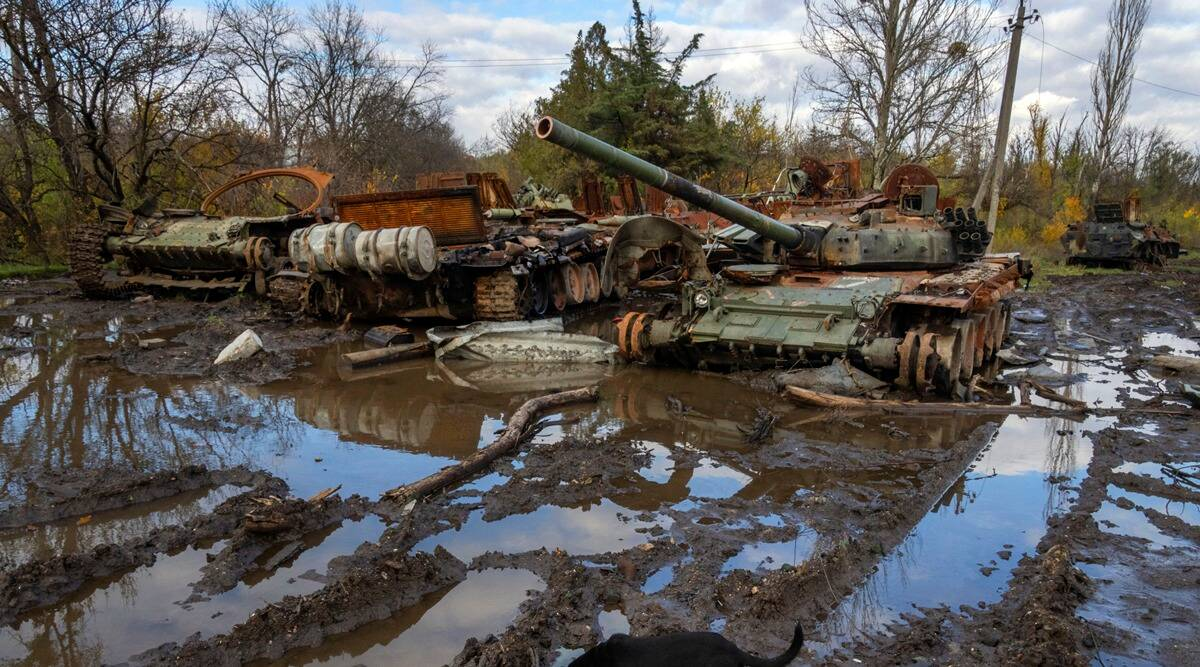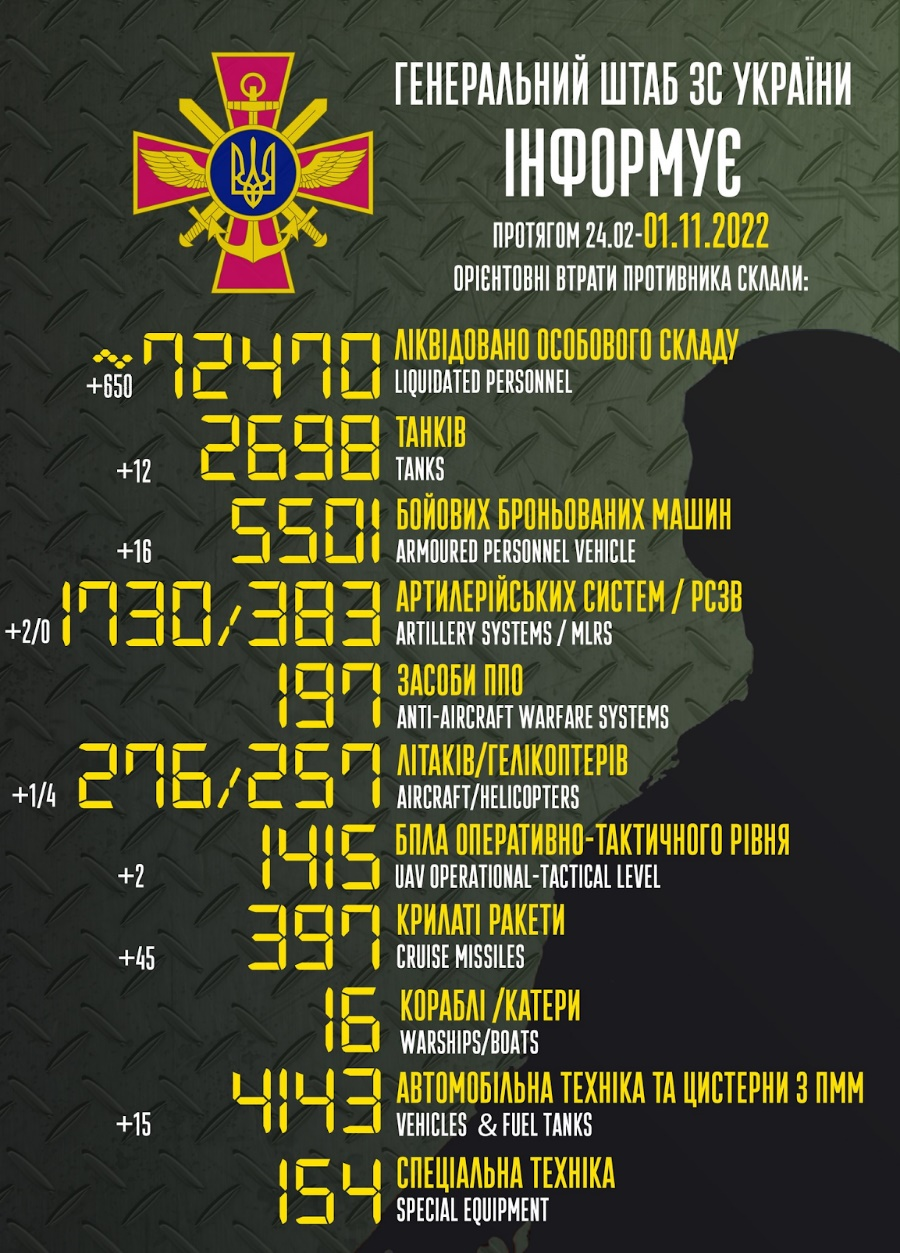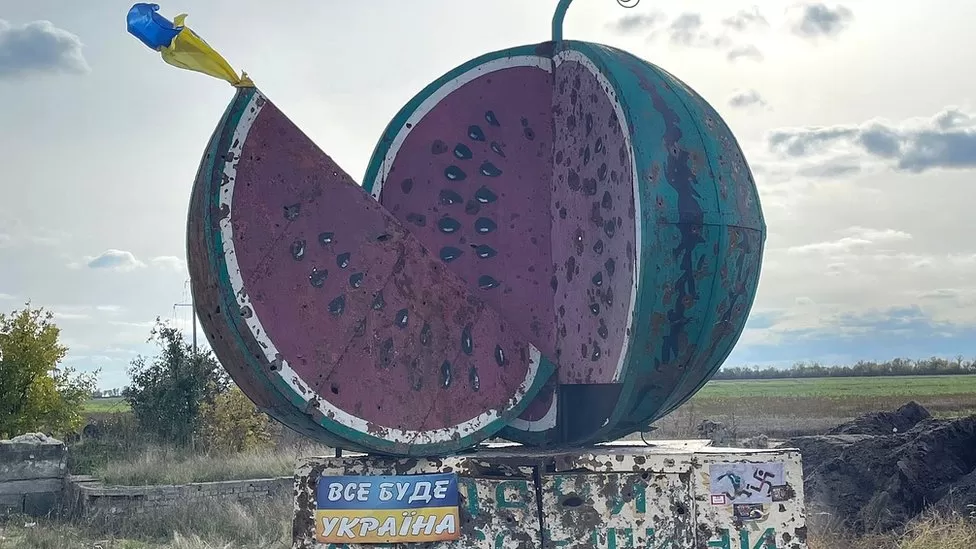
ISW KEY TAKEAWAYS: ENEMY WITHOUT HONOR RETALIATES AGAINST MILITARY STRIKES IN CRIMEA WITH MASSIVE CIVILIAN STRIKES
Above: Enemy strikes on critical civilian infrastructure last 24 hours. (LiveUAMap)
- Russian forces conducted another massive wave of missile strikes targeting critical Ukrainian infrastructure across the country on October 31, likely in an attempt to degrade Ukraine’s will to fight as temperatures drop.
- Russian forces fired over 50 Kh-101 and Kh-555 missiles from the northern Caspian Sea and the Volgodonsk region of Rostov Oblast, targeting critical Ukrainian energy infrastructure.
- The Ukrainian General Staff reported that Ukrainian air defenses shot down 44 out of over 50 Russian missiles. Ukrainian Prime Minister Denys Shmyhal reported that the strikes damaged 18 mostly energy-related targets across 10 Ukrainian regions.
- Ukrainian officials reported that Russian strikes cut off water to 80% of Kyiv residents on October 31 and left hundreds of thousands without power.
- Wagner financier Yevgeny Prigozhin continued his efforts to increase his status among Russian elites and his presence in St. Petersburg by attacking local officials and announcing the creation of a PMC Wagner Center in St. Petersburg on October 31. Prigozhin may or may not create his own political party, but he is establishing himself as a political force, using his popular status and his affiliation with Wagner to critique his opponents within elite circles and to institutionalize his own authority.

Photo: Kyiv’s large network of subway stations are used for bomb shelters. (UNITED24)
Photo above: BBC
- The Russian Ministry of Defense is likely attempting to prevent draft dodging by trying to deceive the Russian population into believing that autumn conscripts will not be sent to fight in Ukraine, claiming, the regular autumn conscription campaign, which will begin on November 1, has “nothing to do with the conduct of the special military operation in Ukraine” and that uniforms, equipment, and food have already been provided at training grounds and that conscripts will receive five months of training and then will receive positions appropriate to their education and skill.
- However, Russia’s illegal and unrecognized September annexation of occupied Ukrainian territory means that all of the fighting is taking place in areas that the Kremlin claims as Russian territory. Conscripts will almost certainly be deployed to Ukraine after their training is complete around March or April 2023, and could be deployed sooner in response to changes on the battlefield.
- The russian MoD also announced the end of partial mobilization on October 31. The MoD will likely continue to order surreptitious mobilization under the guise of “volunteer battalions” where it thinks it can get away with it but needed to end the partial mobilization process to free up space and trainers for the new November 1 conscription class.
- Local Russian governments remain responsible for even basic provisions to mobilized personnel, demonstrating the inefficiency of crowdfunding efforts and uncoordinated supply lines to support a modern military.
- A local Republic of Tatarstan media outlet reported on October 30 that residents of Naberezhnye Chelny sent 6 trucks containing 100 tons of “humanitarian aid” including food, equipment, and “essential items” to mobilized personnel from Tatarstan serving in the Northern Military District. Framing basic troop provisions crowdsourced from local governments and residents as “humanitarian aid” belies the shockingly poor conditions in which forcibly mobilized personnel are serving.
- The head of the russian Crimean occupation administration claimed on October 31 that his government was purchasing basic winter gear, including thermal underwear, sleeping bags, and protective helmets for mobilized Crimean personnel through “extrabudgetary sources.
Photo above: Indian Express
Ukrainian General Staff of the Armed Forces estimated enemy losses for last 24 hours
- Liquidated personnel, 7,470 (+650)
- Tanks, 2,698 (+12)
- Armored personnel vehicles, 5,501 (+16)
- Artillery systems/MLRS, 1,730/383 (+2/0)
- Anti-aircraft warfare systems, 197 (0)
- Aircraft/helicopters, 276/257 (+1/4)
- UAV operational-tactical level, 1,415 (+2)
- Cruise missiles, 397 (+45)
- Warships/boats, 16 (0)
- Vehicles and fuel tanks, 4,143 (+15)
- Special equipment, 154 (0)
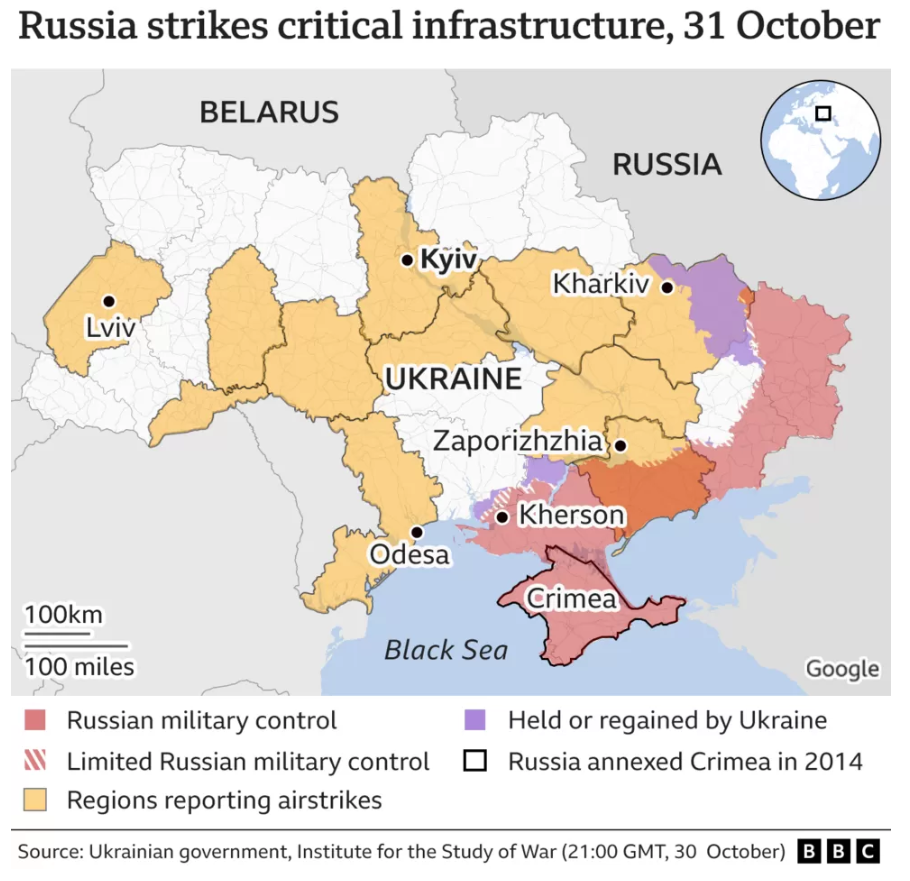 Map: BBC
Map: BBC- The enemy strikes critical infrastructure and civilian homes, violating international humanitarian law, laws and customs of war.
- In total, the enemy carried out up to 10 airstrikes and launched more than 20 attacks from rocket salvo systems. In addition, the infrastructure in the districts of Kyiv, Poltava, Zaporizhzhia, Kharkiv, Cherkasy, Chernivtsi and other regions suffered enemy rocket attacks. The enemy attacked military and civilian infrastructure facilities with 55 air-guided missiles, 45 of which were shot down by our defenders.
- The situation in the Volyn and Polissya directions has not changed significantly. The republic of belarus supports the armed aggression of the russian federation against Ukraine. The russian federation continues to transfer individual units to the territory of the republic of belarus. The threat of missile strikes and the use of attack UAVs from the territory of this country remains.
- The enemy shelled in other directions:
- in the Siversky direction – from mortars and barrel artillery, in the area of Mezenivka, Sumy oblast;
- in the Slobozhanskyi direction – from tanks, mortars, barrel and rocket artillery, in the areas of Dvorichna, Zelene and Kamianka settlements;
- in the Kupyansk and Lyman directions – from mortars, barrel and rocket artillery, in the areas of Berestove, Hrekivka, Zarichne, Nevske and Stelmakhivka settlements;
- in the Bakhmut direction – from tanks and artillery of various calibers, in the areas of the settlements of Bilohorivka, Klishchiivka, Mayorsk, Opytne, Spirne, Yakovlivka, and Zelenopillya;
- in the Avdiyivka direction – from tanks, mortars, barrel and rocket artillery, in the areas of Vodyane, Novobakhmutivka and Pervomaiske settlements;
- in the Novopavlivskyi and Zaporizhzhia directions – from tanks and artillery of various types, in the areas of the settlements of Vremivka, Vuhledar and Pavlivka.
- In the South Buh direction, more than 30 settlements along the contact line suffered fire damage. Among them are Novodanylivka, Chervone and Zaliznychne.
Photo: Residents in eastern Kharkiv Oblast use a generator and Starlink dish to connect to internet and charge devices. (New York Times)
 Map: ISW
Map: ISW- Russian sources continued to claim that Ukrainian troops conducted counter-offensive operations in northeastern Kharkiv Oblast and along the Svatove-Kreminna line on October 30 and 31.
- Geolocated footage posted on October 30 showed the aftermath of an explosion of a bridge across the Krasne River in Krasnorichenske, 15km north of Kreminna, suggesting that Russian forces may be conducting a deliberate withdrawal from settlements north of Kreminna in anticipation of Ukrainian advances.
- The Ukrainian General Staff noted on October 31 that Russian troops shelled Ploshchanka (15km northwest of Kreminna), indicating that Ukrainian troops are continuing to advance towards the R66 Svatove-Kreminna highway north of Kreminna.
Photo: Kramatorsk, the capital of Donetsk Oblast since enemy occupation of Donetsk city in 2014. (CNBC)
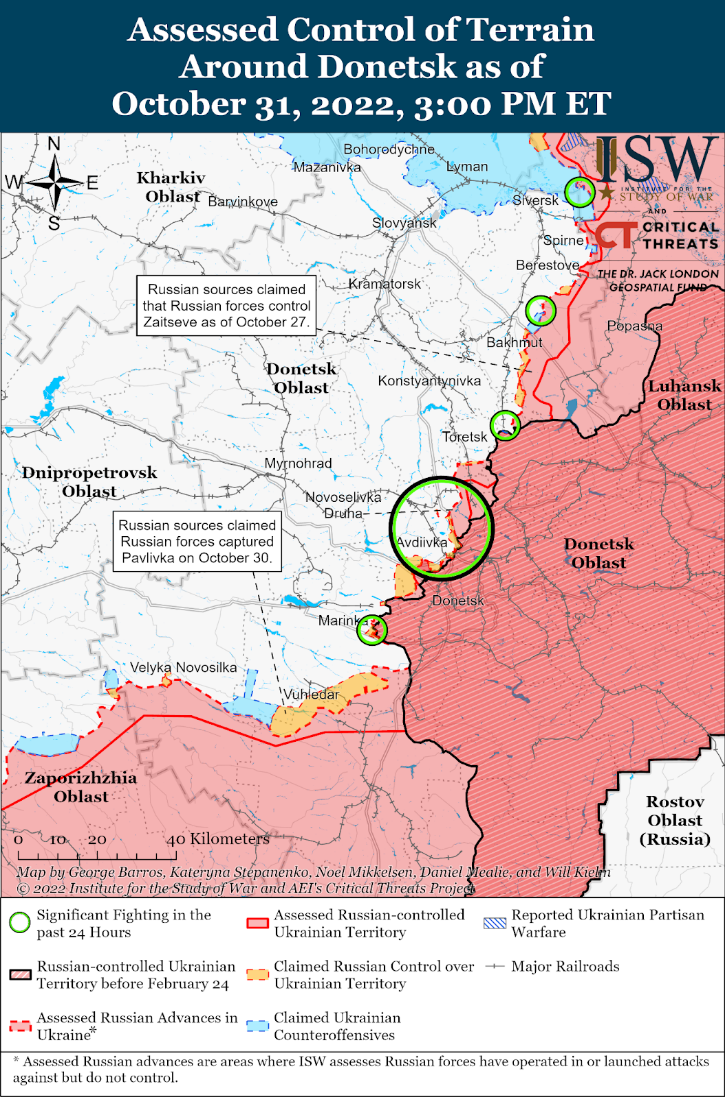 Map: ISW
Map: ISW- Russian forces continued ground attacks around Bakhmut on October 30 and 31.
- Wagner Group financier Yevgeny Prighozin stated that Wagner forces are only advancing 100–200 meters per day, exaggerating the negligible rate of advance that Russian troops have made south of Bakhmut over the last weeks.
- Russian milbloggers also claimed on October 31 that Wagner troops are engaged in fierce fighting northeast of Bakhmut around Yakovlivka and on Bakhmut’s northeastern outskirts.
- Russian sources claimed that Russian troops made incremental gains in the Avdiivka-Donetsk City area on October 30 and 31. The Ukrainian General Staff reported that Russian troops conducted a series of unsuccessful ground attacks on the northern, northwestern, and southwestern outskirts of Donetsk City on both October 30 and 31.
Photo: “Everything will be Ukraine”. (BBC)
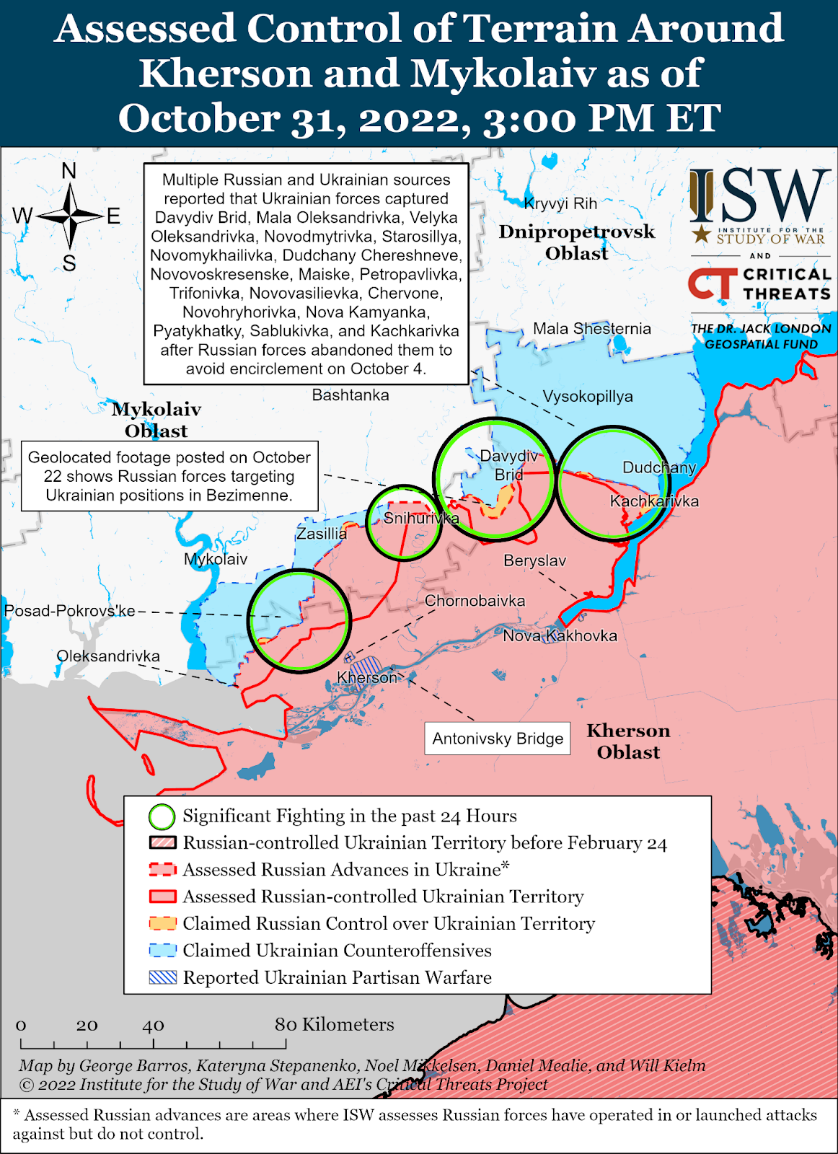 Map: ISW
Map: ISW- Russian forces continued defensive operations in Kherson Oblast on October 30 and 31. Ukrainian military sources reported that Russian troops are conducting remote mining of areas near the Kherson Oblast frontline, evacuating military assets to the east bank of the Dnipro River, and reforming units (likely adding newly mobilized reservists to reconstitute shell units).
- Ukrainian military sources reported on October 30 that Russian forces are preparing to move artillery units and weapons from the west bank of the Dnipro River for possible redeployment in other directions.The simultaneous evacuation of military assets from the west bank and preparations for the defense of critical areas around Kherson City indicate serious anxiety over Russian control of the west bank.
- Russian sources reported that Ukrainian forces attempted to break through Russian lines in the Beryslav Raion — the area where Russian lines are currently stretched the furthest — on October 31.
- Russian occupation officials once again shifted their rhetoric regarding the Kakhovka Hydroelectric Power Plant and are likely setting information conditions to continue to drive evacuations from the west bank of the Dnipro River and provide rhetorical cover for a Russian withdrawal from the area.
- Kherson Occupation Head Vladimir Saldo announced on October 31 that his administration is expanding the evacuation zone by 15km from the Dnipro River and cited information that Ukraine is preparing for a “massive missile attack” of the Kakhovka HPP dam, which Saldo alleged will cause massive flooding and destruction of civilian infrastructure.
- There is no scenario in which it would be advantageous for Ukraine to blow the dam. The ramifications that such an action would have on the safety of the Zaporizhzhia Nuclear Power Plant (ZNPP), which relies on the water in the Kakhovka reservoir for coolant, and the economic and social implications of flooding over 80 settlements and destroying civilian homes and viable land, entirely preclude the possibility that this is a contingency Ukraine may pursue.
Latest news
Petretskyi: Strength of Ukrainian unity shall overcome Russian aggression
December 19,2025
233
Ukrainian national luge team joins weekly peace march in Lake Placid
December 19,2025
139
Protests resume in London against pro-Putin Russian opera star Netrebko
December 19,2025
343
Republican senators urge Trump to confiscate frozen Russian assets for Ukraine
December 19,2025
341


